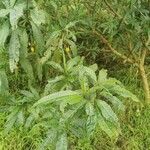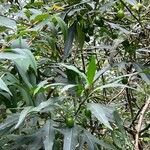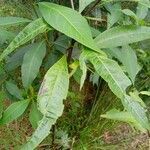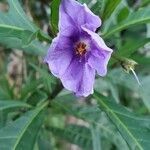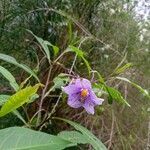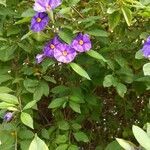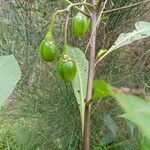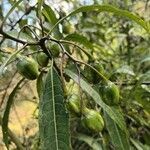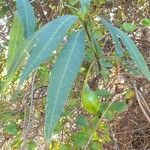Erect shrub to 4 m, dark green, glabrous except for glandular and minute, simple, non-glandular hairs on young growing points and corolla apices; stems angular with raised lines; prickles absent. Lobed leaves broadly elliptic to obovate; lamina 15–30 cm long, concolorous, the lobes 1–10 cm long, 0.5–2 cm wide; petiole to 4 cm long. Entire leaves lanceolate-elliptic, the lamina 8–25 cm long, 1–3.5 cm wide, concolorous; petiole 1–2 cm long. Inflorescence up to 10-flowered; peduncle to 35 mm long; rachis to 15 cm long, often forked at base; pedicels 15–20 mm long. Calyx 5–6 mm long; lobes triangular, 1.5–3 mm long. Corolla rotate-stellate, 25–40 mm diam., blue-violet; lobes acute. Anthers 3.5–4.5 mm long. Berry ovoid to ellipsoid, 10–15 mm diam., bright orange-red to scarlet. Seeds 1–1.5 mm long, light brown or reddish-brown. Stone-cell granules usually 1–1.5 mm long.
Glab. soft-wooded branching shrub or small tree up to ± 3 m. tall; stems green or purplish. Lvs alt., dark green, membr. to subcoriac., (4)-15-30-(40) cm. long, lanceolate or linear-lanceolate, entire or irregularly pinnatifid (us. on same plant) with c. 1-3 lanceolate acute lobes; petioles decurrent. Fls axillary in 1-3 few-to many-fld cymes. Calyx-lobes short, broad, spreading. Corolla broadly campanulate to rotate, up to 3·5 cm. diam.; lobes c. = tube, lanceolate; lavender, paling towards margins, or white. Filaments = or > anthers. Anthers oblong, spreading, opening by apical slits. Berry broadly ovoid, 20-25 mm. long, drooping, yellowish. Seeds < 2 mm. long. Baylis (loc. cit. 639) gives: n = 23, average pollen-grain diam. 25-31 µ; stone-cell masses in ripe fr. inconspicuous, only exceeding the seeds in size when coalescent.
A shrub which keeps growing from year to year. It grows to 2-4 m tall and spreads to 5 m across. The stem is erect with spreading branches. The stems are purplish-green and angular. The leaves are dark green and 10-30 cm long and 1-12 cm wide. Normally the leaves are deeply divided into long tapering triangular segments. The leaf stalks are 3 cm long. The flowers are blue or purple and 3.5 cm across. They are 5 sided or star shaped with sharply pointed lobes. They develop in bunches in the axils of leaves and towards the ends of branches. The bunches can be 5-13 cm across. The fruit are egg shaped berries. They are orange, red or yellow and 2.5 cm long. There are several seeds inside the soft pulp.
